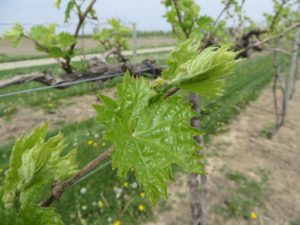Grape growth is a bit ahead of normal this year. Grapes are at the critical 1 to 3 inch shoot length when Phomopsis cane and leaf spot infections occur. This is a critical time to take control measures for this disease. If left unchecked, the early shoot infections will spread to cluster stems and developing berries. The disease remains latent during most of the season until fruit maturity begins. Then the fungus develops in berries or cluster stems and causes a soft, brown rot. Losses can be 50% or higher and overall fruit quality is greatly diminished.
Control of Phomopsis is relatively easy with captan or mancozeb. Mancozeb is the preferred fungicide because it is broad-spectrum and also controls black rot and downy mildew. It is important to understand that captan and mancozeb are protectant fungicides and must be on the plant before any infection periods occur. So they must be applied before the next rain event and reapplied after a major rain event. Fungicide applications are needed on a 7-10 day interval through bloom. This is usually about four sprays. Addition of a sterol inhibitor fungicide in the final early season sprays (immediate pre-bloom, bloom and post bloom) will provide additional control of black rot. Many of the popular varieties grown in Indiana such as Traminette, Seyval, Chardonel, La Crescent, and Marquette are highly susceptible to Phomopsis.
